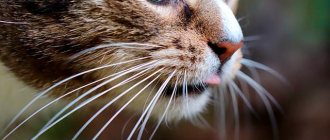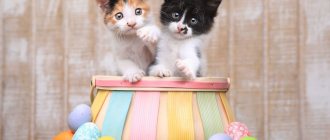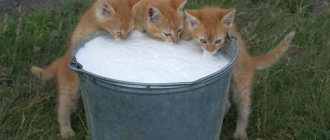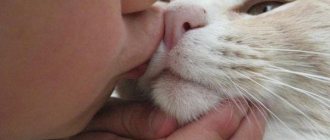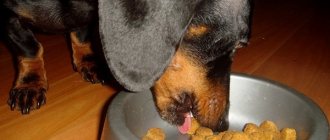When preparing a healthy diet for a domestic cat, many owners are faced with the conviction of many veterinarians who do not recommend adding different types of fish to the animal’s daily menu. In our article we will look in detail at the question of why cats should not fish and what the consequences of regular feeding with this product can be.
Let's start by destroying the stereotypes that have developed over the years: wild domestic cats have always eaten fish, independently caught tasty prey from lakes and rivers, and in general, this product is the basis of their diet.
This is an absolutely erroneous misconception, since by their nature cats are very afraid of water, so they have never been keen on fishing. People came up with a fish menu for domestic cats because of the availability of the product and its comparative cheapness.
Harm to fish and fish products: why shouldn’t you feed them?
Fish contains a large amount of phosphorus and magnesium. These elements improve brain function, but in excess quantities contribute to the imbalance of minerals in the animal’s body, which leads to the formation of stones in the kidneys and urinary system.
Another weighty argument in favor of refusing to regularly feed fish to pets: with regular consumption of this product, vitamin K deficiency develops. As a result of these pathological changes in the body, the following consequences can occur:
- blood clotting worsens;
- there is a serious disturbance in the redox balance;
- problems with hair appear;
- the cat becomes lethargic, inactive, and its natural vitality is lost;
- allergic reactions may occur;
- high probability of helminthic infestation;
- Inflammatory processes develop in the body.
Can kittens be given raw fish: no, this product cannot be given even to adult animals. Raw fish contains thiaminase. With frequent use of such a product, a serious deficiency of vitamin B1 appears.
Subsequently leads to the development of certain neurological diseases. The cat may experience seizures and paralysis. The functioning of the digestive system also deteriorates and a pathological disorder of carbohydrate metabolism occurs.
If you regularly feed your pet fish, you can significantly shorten its lifespan. Due to deterioration of blood clotting, internal hemorrhages may occur, which will lead to the natural death of the animal. A fatal outcome is also not excluded in case of urolithiasis, which is especially dangerous for domestic cats.
Feeding the animals
I asked the veterinarian. The answer was: definitely raw. Raw sea
. If you give it boiled, then it’s better not to give anything fishy at all.
A comprehensive answer can be found here. In my opinion, there are more than enough arguments! https://www.po4emu.ru/content_category/jivotnie/58.htm
Pear! For me, communication on the forum is primarily an exchange of experience. You can, of course, argue and prove your point of view, this applies to both you and others. I just share my information and try to listen to the opinions of other people, but I prefer to check, re-read any information, find answers in articles. After all, vets are people too and everyone has their own opinion, and our task is to take into account all the pros and cons, and The main thing is not to harm your pets.:-B
Message from Kasyun
Pear! For me, communication on the forum is primarily an exchange of experiences.
Well? Am I preventing you from changing your experience by expressing my point of view?
Well, actually, not all fish contain the thiaminase enzyme, but herring and carp: herring, sprat, mackerel, pollock, cod and the enzyme is contained mainly in their insides (.) ... besides, some serious damage to B1 could be reported I would say with a constant diet of this fish... B1 is still needed by the body in minute quantities, which cannot be said about calcium, which is not absorbed at all without vitamin D... if we are talking about antivitamins, then many who like to give raw eggs to cats also “expose” them danger, because egg white contains ovidin, a protein that binds biotin and prevents its absorption in the intestines of cats...
About feeding your cat (proper nutrition)
First, let's talk about the features of the physiology of digestion in cats. We must remember that cats are purely carnivorous animals (unlike, say, dogs, which are conditionally carnivorous)! Cats are predators, so they have certain characteristics in their needs. These characteristics include dependence on the amino acid arginine, which is part of proteins only of animal origin; dependence on the amino acid taurine, the deficiency of which causes dysfunction of the nervous system, cardiovascular system, etc.
Taurine is found in fish, lamb and beef. It is also necessary to have fats of animal origin in the diet, because... they are a source of arachidonic acid, important for cats. Fats of animal origin cannot be neglected. They are a source of fatty acids that regulate the condition of the coat, etc. Those. what is the conclusion? The diet should consist of 80-90% protein foods.
"Natural"
First, let's talk about the homemade diet, the so-called “natural diet”. As you already understood, feeding a cat pasta, bread, cereals, etc. wrong, because fiber and cellulose (which are rich in foods of plant origin) are simply not digestible by cats.
So, for natural feeding there are 4 food groups:
- Meat and fish
- Dairy and eggs
- Fats and oils
- Vegetables and grains
- + Mineral and vitamin supplements
Now let's talk about everything in order.
MEAT and fish:
it could be beef, chicken, turkey, rabbit, offal.
- beef: finely chopped, scalded, streaked (streaked is even better than
veal fillet, because there is more water in the fillet)
- lamb: young, lean
- rabbit: best boiled
- pork - better to refuse! You can VERY rarely, and then boiled tenderloin. Fatty meats can cause vomiting and gastrointestinal upset.
Those. a cat needs 50-100g of minced meat per day (but not minced meat! Minced meat passes through the intestines too quickly, without stimulating it and without creating a feeling of fullness).
By-products:
liver (no more than once a week, well scalded because raw it can act on the intestines as a laxative, boiled - it strengthens, and it’s not worth it more often, because it is low in calcium and sometimes causes allergic manifestations), kidneys (soaked for at least 1 hour and boiled), heart (boiled), lung (sometimes, because it is essentially low in nutrition)
Do cats even eat fish?
Of course, cats, like any other living beings, love a varied diet and will never refuse a tasty delicacy called “fish”. However, this product is by no means a natural food for felines, so it is not at all necessary to feed your pet fish products.
Fish contains various microelements necessary for the animal body. But, there are many other useful products that are absolutely safe for cats and have an identical composition.
For example, many owners replace fish with special vitamin supplements for animals, sold in veterinary pharmacies. Dry and wet food is also suitable, containing a complex of nutrients necessary for the vigor and health of your furry pet.
Special feed
Food manufacturers produce special diets for complete and balanced nutrition of cats:
- Monge - in most cases these are monoprotein pates made from beef, chicken, and duck. However, among them you can find canned tuna, vegetables and shrimp. They are safe and designed specifically for feeding sterilized animals.
- Carnilove is a dry food based on lamb, wild boar and poultry. However, the manufacturer also produces salmon-flavored mixtures, a fish that is allowed to be eaten by castrated cats.
- Royal Canin is one of the most popular pet food manufacturers, producing mainly dry food. They are well balanced and contain special additives for the prevention of urolithiasis.
All food can be purchased both in pet stores and on thematic Internet resources. However, before choosing such canned food for your pet, you need to consult a veterinarian.
Owners' opinions
Owners' opinions on the need to include fish in a pet's diet are very contradictory. Many believe that a natural product is better than any canned food, while others responsibly follow the recommendations of experts and exclude fish from the animal’s daily menu.
Let's look at a few arguments coming from supporters of “fish in a cat's diet” and find out what contradictions there are to their statements. All village and street cats eat fish and have no health problems!
Delicious pollock
Pollock belongs to the Cod family. But, despite this, in the minds of housewives, pollock has had a firmly established reputation as a “fish for cats” since Soviet times. Even if people eat pollock, they almost always do it under forced circumstances: in hospitals or in the army. Pollock was and remains one of the cheapest types of fish in Russia, and therefore many are biased towards it.
Meanwhile, in the Far East, pollock is highly valued. There he is caught with a fishing rod, and then immediately fried.
Few people know, but in all McDonald's cafes in Russia, when you order filet-o-fish, you are served pollock. It has become a trademark of the chain due to the amazing whiteness of the muscle tissue, which gives the food a special visual appeal. And no matter where you order this dish - from Petropavlovsk-Kamchatsky to Kaliningrad - the taste of pollock fillet will be the same and quite decent. And all this because the quality standard of this chain is high, and local technologists have managed to achieve impressive results: the fillet is always juicy and elastic.
And yet, the technological minced fish surimi, from which all crab sticks are made, is made mainly from pollock. The choice of fish for minced meat is explained not only by the significant reserves of pollock in the North Pacific Ocean, but also by the elegant whiteness of the muscle mass.
This means we just need to learn how to cook pollock: don’t boil it in soup into tasteless rags, don’t overdry it in the oven. It needs to be fried! Breaded, battered and deep fried
Important: pollock is already lean; when frying it in breading or batter, it is important not to dry it out
ATTENTION! The main problem with pollock is its high infestation of parasites, so it cannot be sold uneviscerated. Therefore, never buy frozen, uneviscerated pollock carcasses at the market!
Therefore, never buy frozen, uneviscerated pollock carcasses at the market!
Pollock goujons with spicy mayonnaise
How much fish can you give your cat?
After reading numerous arguments about the dangers of fish for domestic cats, many owners have a very obvious opinion - this product will have to be completely excluded from the animal’s diet. But this is not entirely true; you can give your cat fish, but sometimes, in a certain quantity and not of all types.
This product, despite numerous harmful components, is still necessary for the animal to maintain normal functioning of the cardiovascular and nervous systems. In order not to cause harm and create an extremely healthy menu for your furry friend, we recommend following the following advice from veterinarians:
- It is better to feed your cat boiled fish. During the heat treatment, dangerous components are destroyed, and helminthic eggs are also destroyed.
- You can serve a fish dish no more than once a week.
- Castrated and sterilized cats are fed fish no more than 2 times a month.
- The animal's diet should contain only sea fish without bones! River species are absolutely unsuitable for domestic cats, as they contain too many small bones that can injure the throat and mucous membranes of the gastrointestinal tract.
- Young cats can be periodically pampered with fatty fish, but mature cats are better fed exclusively with dietary varieties.
- You should not feed your cat fish during pregnancy. The substances included in its composition may adversely affect the development of the fetus.
- The fish must be deboned or choose ready-made fillets that do not require additional processing before feeding.
- Portions should be moderate, appropriate for the weight and age of the pet. Do not serve the dish in large quantities, the cat may not be able to resist such a tasty temptation and will eat to its heart’s content, and this is already fraught with very unfavorable consequences!
- Fish can be served in combination with a side dish, for example, freshly prepared cereal porridge or vegetable puree.
- Do not mix fish with dry and wet food. This type of lunch will not be good for your furry friend.
What about other seafood?
Crabs, crayfish, shrimp, lobsters, lobsters, rapana, mussels, and squid can also be present in a cat’s diet, but only as a rare delicacy. While fish is a light protein and suitable for regular addition to the menu, most seafood is not. In addition, the body of a cat that is not accustomed to such food may simply not accept them and return them back.
Shrimp and squid tend to accumulate heavy metals, so feeding them is not recommended. Shrimp are allowed only 1-2 pieces no more than once a month. If a cat eats a small shrimp with a shell, then there is no need to sound the alarm: most likely, it will pass through the gastrointestinal tract in transit, because... chitinous shells are not digested. Larger amounts will likely be returned via vomiting. Large shrimp should never be served in their shells. Otherwise, they can lead to intestinal obstruction or damage the mucous membranes.
When feeding your cat crayfish and crabs, you need to know that they also have helminths. Therefore, crabs and crayfish are either frozen or boiled.
But in any case, the listed seafood for cats is more likely not useful than useful.
River fish, with bones, smoked, boiled and salted
You can: sea fish without bones, preferably low-fat varieties. It is better to boil the product without salt and other spices. If the owner wants to feed the cat raw fish, it is necessary to first freeze the product and pour boiling water over the meat before feeding. Heat treatment will reduce the risk of parasitic infection.
Do not give domestic cats smoked, salted, fried or river fish with bones. Particularly dangerous species: sprat, saury, capelin, pollock, blue whiting, river and sea perch.
What kind of fish can cats eat: salmon, halibut, cod, pink salmon, salmon, hake, flounder and other sea varieties.
General information
Naturally carnivorous cats need a lot of protein. Cats also need carbohydrates, in very small quantities. With natural feeding, 80% of the food in the diet should serve as sources of protein.
The basis of a cat's diet should be meat - beef, veal, poultry, rabbit. Eating pork is acceptable if the meat is lean and well cooked. It is better to freeze the meat and serve it raw; this method is more natural. An adult cat with healthy teeth is fed meat in pieces. There is no need to cook mince because the teeth remain healthy while the cat needs to chew its food.
Milk and dairy products must be present in a cat's diet. Preference is given to cottage cheese, yogurt, homemade yogurt and natural cheese. Whole milk can cause diarrhea, which indicates lactose intolerance. Store-bought dairy products are made from a powder mixture, so their benefits are questionable.
We invite you to familiarize yourself with: Black German Shepherd
Chicken and quail eggs are a source of protein, fats and vitamins. The only disadvantage of the product is the risk of allergies and high calorie content. Eggs should be present in a cat's diet no more than 1-2 times a week. Quail eggs can be given more often. As for preparation, it all depends on the cat’s preference; some purrs like boiled eggs, and some like raw ones. Alternatively, you can make an omelet from one egg and milk (without butter).
Vegetables, fruits and grass are a source of vitamins and coarse fiber. Your cat must be fed coarse fiber otherwise its digestive system will not work properly. Cats rarely eat vegetables in their pure form, so they are chopped and mixed with cottage cheese or meat. Vegetables can be given raw or cooked.
Cereals are a source of carbohydrates. As mentioned above, a cat does not need large amounts of carbohydrates, so porridge does not need to be given more than 2 times a week. Rice and buckwheat are good for feeding cats; you need to be careful with other cereals.
